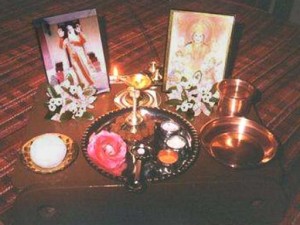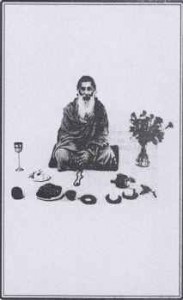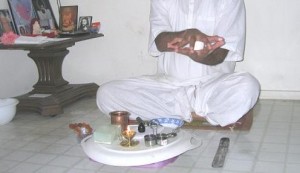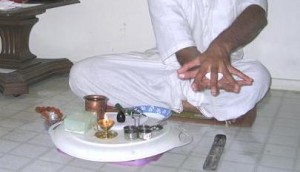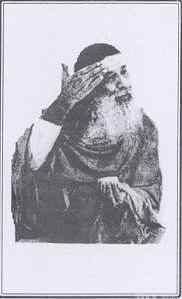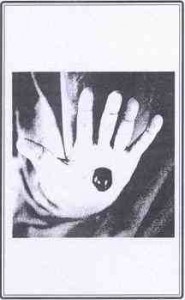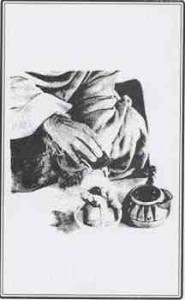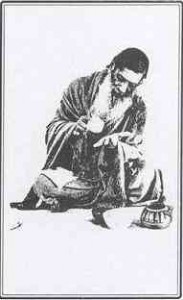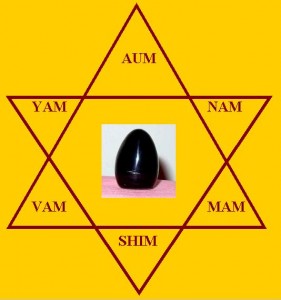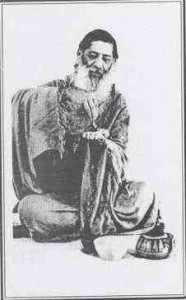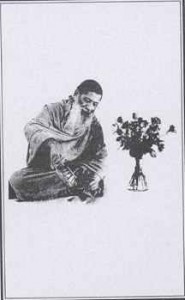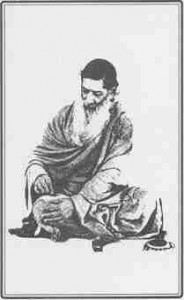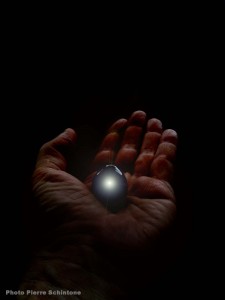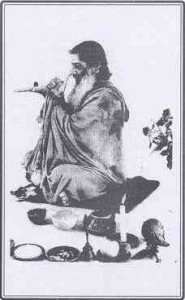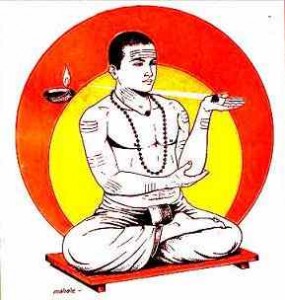Ishta – Linga Pooja ( for more advanced Shiva-yoga practicants )
In the Turiya state – consciousness is existence; the absolute existence and the absolute consciousness are identical, man and the cosmos become one and the same. Such a state is represented by cipher or shunya and the attainment of this state is known as Shunya Sampadane. The avowed aim of upasana or worship of Linga is to attain to this absolute state.
The process of Upasana is simple. The first requisite is that the worshipper is required to remember that the Ishtalinga which he wears is the representative of the Inner Light which is known as Jyotirlinga or Pranalinga. The process involves the worshipping of the Linga with water, flowers, bhasma (or holy ashes), waving of light, incense, bilva leaves, sandal paste, rice grains, and sugar candy. After this process is over, the worshipper begins to gaze over Linga placed on the left palm of his hand, uttering inaudibly the mantra in his mind. The mantra may be panchakshari (five lettered) – NamaShivaya or shadakshari (six lettered) – Om Namah shivaya. The gazing upon the speck of light reflected in Ishtalinga is the essence of drashtiyoga or lingayoga. With half-closed eyes, the devotee fixes his attention upon the light reflected in the Linga, the blue-black coating of which serves to widen and deepen concentration. The concentrated gaze generates psychic heat or tapas, which stirs into activity the dormant pineal gland. This gland, which is the organ of light, produces tejas or psychic light. This in turn, leads to the release of ojas or the thought-force which is at once the power of vision and execution. Shivayoga therefore lands one into a region of effective will and intuitive knowledge, where to will is to create and to think is to see. This is the secret and significance of Shivayoga.
This process of Ishta-linga worship called as “Ashta-vidhan” pooja ( Eight fold greetings to Ishta-linga ) is explained in detail as below.
Necessary items for pooja, which is called Ashta-vidhana pooja:
. Ishtalinga. 13-bead rudrakshi. bhasma. cup, bowl (copper is best!). water. two pieces of cloth. incense, camphor, oil lamp. ashtagandha powder. rice, sugar-candy. bell. flower, bilva leaf
picture showing pooja items
1. Sit (preferably on the floor) in padmasana or some easy, comfortable but firm posture. Wear comfortable clothes of natural material.
Sit in padmasana or some easy, comfortable but firm posture.
2. Light an incense stick and oil lamp.
3. Hols bhasma in Kurang mudra (shown below) and hold both hands near chest in Namaskar position and remember your Guru’s name in your mind.
4. Now purify bhasma over the flame of the oil lamp, using kuranga mudra. This means you should place bhasma on your left palm while fingers are spread. Cover your left palm with the right open hand, fingers are also spread and the tips of both hands touch. The wrists of both hands should also touch. Start to circle bhasma in clockwise movement over the flame for a few times.
Kurang Mudra during Ashta-vidhan pooja
5. With bhasma still ‘captured’ in kuranga mudra, do the eightfold namaskara to Ishtalinga: begin from the heart centre, then touch the centre between the eyebrows, right shoulder, left shoulder, right knee, left knee, top of the forehead and then swing your folded hands over your head and return to the heart centre.
6. Do not wipe off the traces of bhasma from your palms! Instead, apply it evenly on your face and arms, using both palms. Bhasma is sacred and blessed by Gurudeva and is therefore an excellent protection for your body. Next, gently rub your right-hand index finger, middle finger and ring finger on bhasma and apply it on your forehead 3 times (do not spread your fingers, keep them together!). The three lines of bhasma on your forehead ward off the negative effects of prarabdha, sanchita and agami karmas. Then, with the tip of your middle finger put a dot of bhasma between your eyebrows, and still with the same three fingers apply bhasma once on the area of vishuddhi chakra (throat), then touch eyelids and ear laps. Apply bhasma again with the three fingers twice on your right lower arms, across the outer part of both elbows, then twice on your upper arms, across the chest, behind each shoulder, and finally on top of your head. Put bhasma back in its bowl
Apply Bhasma on your forehead 3 times (do not spread your fingers, keep them together!)
7. Take your Ishtalinga and place it on the palm of your left hand. The sign on the Ishtalinga should always face the thumb.
Place Ishtalinga on the palm of your left hand.
8. Immerse the tip of the ring finger in water and draw a wet line along your left index finger. This will enable the water to flow directly and evenly into the bowl.
9. Pour some water over Ishtalinga, repeating the shadakshara (six-lettered) Maha-mantra (Great mantra) OM NAMAH SHIVAYA in the mind 2-3 times.
Pour water over Ishtalinga, repeating the shadakshara (six-lettered) Maha-mantra
10. Still holding Ishtalinga in the centre of your palm, take bhasma, hold it with left hand fingers and rub all five finger-tips of your right hand on bhasma, then dip them in the water. The water is now purified and holy. Sprinkle all the pooja items and your surrounding with this purified water, including yourself!
11. Pour purified water over Ishtalinga, repeating OM NAMAHA SHIVAYA in the mind.
12. Dry your palm thoroughly, dry Ishtalinga also, using a clean piece of cloth which absorbs water well.
13. Gently rub Ishtalinga in one direction only – from the knee towards the body. For that purpose use soft flannel cloth.
14. Keep Ishtalinga on your right knee while you draw a hexagon on your left palm with bhasma. Hexagon means two opposite triangles, on top of each other, with one apex turned downwards and the other appex turned upwards (the meaning of both triangles should be clearly understood so reference is made to Gurudeva’s lectures from 1994). In each ofthe six small triangles (representing 6 chakras) one syllable of the shadakshara mantra is to be written using bhasma, beginning with the first triangle on the right side of the palm (clock-wise direction):NAM refers to muladhara chakra and its element earth; MAM, refers to swadisthana and its element water; SHIM, refers to manipuraka and its element fire; VAM refers to anahata and its element air; YAM refers to vishuddhi and its element ether; OM refers to agneya and its element the Soul. The meaning of this should be studied and remembered. Still using bhasma, press a dot in the middle of the palm. This dot denotes sahasrara and there Ishtalinga should be placed (always taking care that the sign of the linga is facing the thumb).
Draw a hexagon on left palm with bhasma and write one syllable of the shadakshara mantra in each triangle using bhasma.
15. Apply three lines of bhasma on Ishtalinga using right-hand index finger, middle finger and ring finger.
16. Put rudrakshamala around the Linga, the meru bead facing the wrist.
17. Touch the water with the tip of the ring finger, take some ashtagandha powder and offer it, i.e., just show it to Ishtalinga and then apply it to the centre between your eyebrows.
18. Offer a few grains of rice by putting them on the palm, close to Ishtlinga.
19. Offer pooja items to Ishta-linga
Offer pooja items to Ishta-linga
20. In the same way, offer sugar-candy.
21. In the same way, offer one small flower and bilva leaf
22. Wave incense stick (in clockwise direction) a few times in front of Ishtalinga and bow down with Guruji’s name in the mind
23. In the same way, wave the flame of oil lamp and bow down
24. Light camphor and wave it in front of Ishtalinga, always with Guruji’s name in the mind.
25. Immerse the tip of your index finger in the holy water and wave the finger in front ofthe Linga, always in clockwise direction. Keep the index-finger straight.
Ring the bell which means, « Oh God, please come and give me Your blessing! »
26. Do clock-wise Pradakshina, i.e., going around Ishtalinga 3 times using right hand, all fingers folded, except small finger which is kept straight. Each time bow down. This is the same as doing Pradakshina after taking darshan in the Divine Temple.
27. Remove all the offerings from the palm, but do not remove Ishtalinga. Put bilva leaf, rice and sugar-candy in the holy water. After the pooja is over, they will be taken as prasada! When you drink holy water, never touch the cup with your lips!
28. Sprinkle the holy water (which is the symbol of padodaka) three times over Ishtalinga, fIrst repeating Guru, then Linga, then Jangama. Remove the Linga from the palm, put it on a piece of cloth, drink the water from your palm, holding the arm with your right hand (this means you take the holy water with both of your hands!). Finally, run the wet palm over the top of your head with Guruji’s blessings.
Pouring water – Pado-daka at the end of worship
29. Dry Ishtalinga and the palm thorougly with a piece of cloth.
30. Rub the palm well on soft cloth. The palm should be warm.
31. Gently rub Ishtalinga. It becomes very shiny and charged with electricity (see the scientifIc explanation of this gentle rubbing in Swamiji’s lectures).
Gently rub the Ishta-linga towards you (only in one direction)
32. Place an oil-lamp or a candle behind and just a little above your left shoulder.
33. Shiva-yoga is to be practised in the dark, so make sure the lights in the room are turned off or the blinds are closed.
Make sure that lights are turned off.
34. Place Ishtalinga on the left palm and do namaskara (circular anti-clockwise movement with the open palm, keep fingers together!) and then determine the distance between Ishtalinga and the eyes. For that you have to fold all your fingers except the thumb which is kept straight, with its tip touching the nose, while both the wrists are pressed against each other.
Take appropriate distance between left palm and eyes
35. Support your left arm by tucking your right hand under the left arm-pit.
36. Gaze with half closed eyes at the speck of the light reflected in Ishtalinga. Do not blink. This unblinking gaze is called Tratak and your one-pointed concentration on the light reflected in Ishtalinga is called Dharana. As you gaze at the speck of light, all the time repeat mentally and slowly OM NAMAH SHIVAYA. The candle or oil-fed lamp should be placed behind and just a little above your left shoulder, so that the speck of light is seen in the centre of Ishtalinga. Start with only fIve minutes of practice. Time will increase on it own. Optimal time of Shivayoga practice is 30 minutes, but you can safely continue up to one hour or as long as you are comfortable. In case your eyes become uncomfortable in the beginning, due to unblinking gaze, take a piece of cotton, immerse it in water and wipe your eyes. You will immediately feel a relief. This is Guruji’s advice.
Yoga students practising Shiva-yoga
Never leave your place immediately after the practice is over. Sit for 5-10 minutes in perfect peace and silence and the benefIt derived from the practice of Shiva-yoga will be well preserved.
——————————————————————————–
This article ‘Ashta – Vidhan’ pooja is prepared by Gurudeva’s ardent disicple and devotee from direct learning the pooja from His Holiness Mahatapsvi Shri Kumarswamiji.


